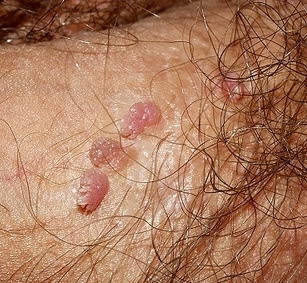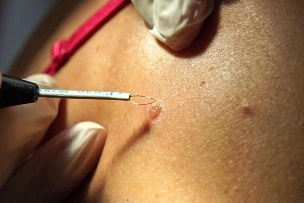
More often than not, people do not suspect that they have human papillomavirus (HPV) virus in their body. This occurs because papillomavirus virus is usually present in latent form, suppressed by natural immunity. Problems arise when it gets out of control and begins to actively manifest itself in the form of growth on various parts of the body. Men are less likely to have the effects of the virus than women, however, for them, it can lead to serious problems in the form of papillomas on the penis.
Reasons to happen
Viral DNA enters the body through microfilms in the skin or mucous membranes. If a man's immunity is weakened, the first manifestations of HPV will appear several months after the infection.
Up to 80% of transmission occurs through the sexual route. Barrier contraception minimizes the risk of infection, but does not completely eliminate it.
Other ways of infection:
- Family path.The virus is transmitted along with the personal belongings of an infected person: clothing, hygiene items, etc. The risk of transmission is increased if the skin is damaged, even slightly. This pathway is characterized by infection with low-oncogenic types of the virus. They do not lead to serious health problems, but appear in the form of genital warts, papillomas and warts, creating a cosmetic defect.
- From mother to baby.If the mother became infected with HPV during pregnancy and childbirth and was born naturally, the baby is likely to become infected.
If a man has good immune protection, the virus does not manifest itself and can stay in the body for a long time in latent form. Therefore, it is not infection with the virus itself that is dangerous, but a weakening of the immune system, leading to HPV activation.
There are several factors that affect the possibility of strengthening the position of the virus:
- chronic diseases; hormonal problems
- ; incorrectly selected contraception
- or its complete absence; Viral infections
- ;
- alcohol, smoking or long-term use of antibiotics; stress often
- .
All of these factors negatively affect the immune system. If there is not one motivating factor in human life, but several others, this will lead to more rapid development of the papillomavirus.
Signals
Papillomas are often only externally visible, however in some cases there may be nonspecific symptoms:- itching and burning during intercourse;
- pain when touching papillomas; accumulation of urine
- in the folds of the penis; unpleasant odor
- in the affected area.
In addition, neoplasms can grow and affect not only the area of the penis, but are also visible on the anus and pubis.

What papillomas look like
Penile papilloma is a small neoplasm. At first, she may appear alone, but without proper treatment, the number of papillomas increases. However, they can merge with each other.
These growths resemble flesh-colored or pink cauliflower inflorescences. They are often localized in the foreskin, head and frenum. Less commonly, they are diagnosed in the urethra and scrotum. Papillomas can also appear as small white pimples that appear in long layers. This form is typical for localization in the constraint area.
Buszke-Levenshtein's warts are one of the manifestations of HPV. It is distinguished by its rapid growth, its outstanding size and its resistance to various types of treatment. It appears due to the presence of several papillomas and warts, which come together and form a large area of a single lesion. The presence of a Buschke-Levenshtein condyloma is dangerous because the cells it converts could easily develop into cancer.Which doctor to contact
A urologist usually deals with the diagnosis of papillomas in men. You can also seek advice from a dermatovenerologist or proctologist if you have genital warts in the anal area. However, papillomas are usually referred to a surgeon for removal. In general, the diagnosis is made in several stages:- The urologist examines and interviews the patient.Oral questioning is essential to assess the patient's lifestyle and to find out the cause of the virus infection. A visual examination involves not only assessing the condition of the penis, but also the nearby organs - the scrotum, the anal area. This is necessary to complete the picture of the localization of the virus.
- Smear urethral.Determines the presence of various sexually transmitted diseases.
- PCR.This analysis not only shows the presence of HPV in the body, but is more likely to determine its type.
- Meatoscope.This procedure involves examining the urethra if the frenum is infected with the papillomavirus. After removing the papilloma, the doctor may order a biopsy to assess the condition of the removed tumor. This is necessary to eliminate the risk of developing cancer and to ensure that the papilloma is benign.
In this case, it is desirable to conduct a survey of both partners. A woman is usually infected with one of the types of papillomavirus. If only a man is treated, he is unlikely to become ill again after a while.
Why papillomas are dangerous
Other related diseases are often associated with human papillomavirus. The appearance of papillomas in the glans penis area contributes to the accumulation of urine in the folds. This creates conditions for the emergence and growth of various microorganisms, which in turn lead to infections. They can stimulate erosion around the papilloma, and also contribute to inflammation of the urethra and testicles. These diseases are characterized by problems with urination, pain and high fever.
Another risk of trauma to neoplasms, leading to bleeding. This happens because many blood vessels form around the papillomas, which supply blood to them. Slight damage can lead to infection due to injury.
Also, neoplasms can rub while moving, causing pain and discomfort for a man.
HPV and cancer
When the virus is just starting to spread, neoplasms are arbitrary and benign. Without treatment, they grow and merge with each other. Over time, the cells degrade into malignant cells.The risk of cancer is very high if a man is infected with highly oncogenic types of the virus - 16 or 18.These are the ones that contribute to the appearance of cancer of the penis and bladder.
Treatment of papillomas
HPV treatment involves not only removing its external manifestations, but also strengthening the immune system, which would inhibit the expression of the virus.Immunostimulating drugs are used to maintain immunity.
As an antiviral drug, an ointment that inhibits the multiplication of the virus and slows small growth is effective. It does not always deal with the task of completely removing it, but it does prevent new growth. Antiviral ointment is prescribed to stimulate immunity. The ointment does not remove papillomas, but promotes the activation of cells of the immune system, which stops their growth and development.

Removal Methods
There are several ways to get rid of emerging new growths:
- Laser removal.The papilloma is exposed to a laser beam, which completely burns the growth. A crust forms in this place, which subsides after a few weeks. The method is considered effective due to lack of relapse. Transfer is performed under anesthesia. There is no bleeding, no scarring or scarring.
- Cryodestruction.Papillomas are exposed to liquid nitrogen. It immediately freezes the desired area, the neoplasm falls on it and it dies. The disadvantage of this method is the inability to control the depth of the crystal-building effect. A crust remains at the site of the removed papilloma, which disappears after a while.
- Radiation surgery.The principle of this method is similar to laser removal. Radio waves do not leave scars and scars, and before the procedure is pre-anesthetized with a special sprayer. After that there are no complications, and the body recovers quickly.
- Electrocoagulation.Growth is affected by an electric current, which causes the foot to be removed, leading to the disappearance of the papilloma. Surface anesthesia may be given if necessary. The procedure takes a few minutes, is extensive and affordable. But this method is able to leave scars after healing.
- Surgical intervention.It is used in rare cases when the tumor becomes too large. It is performed under anesthesia, has long healing and trauma. The method is good in that it allows you to save the extracted growth for histological examination.
Before choosing a method, consult your doctor. It will tell you what is best to use in your case, it will tell you in detail how the procedure is performed. Also, after removal of the neoplasm, it is recommended to take the material for histology. This is necessary to determine whether the degenerative process of benign neoplasms to malignant ones has begun. This method will help detect early cell changes and prevent the spread of cancer.














































































